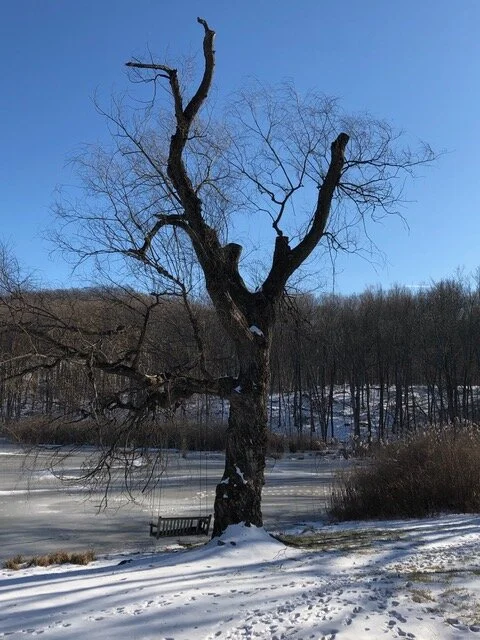Women, Trees and Collaborative Leadership
““A willow tree in my “community”, beaten up by the strength of recent storms from our changing climate. But as tree experts tell me you can’t kill a willow. And yes, women have been “beaten up” by our patriarchal world culture, but we are rising, the feminine is rising.””
Dear Sisters,
I have been sensing for a long time that, if any group can come together across color, tribe, country, and exert the collaborative leadership and intelligence that our planetary survival is demanding, it is women.
Women are far from perfect but really, what other group includes half of humanity and has the capacity to do this?
Many people I share this thought with agree with my assessment.
In the last 30 years or so, I have delivered negotiation programs to thousands of men and women all over the world. It’s often been an “aha” -- especially to non-dominant groups -- that collaboration is one of the two main negotiation strategies. (Competition is the other). As a woman, this was a real eureka for me when I first learned this at Harvard, as I know it has been for the thousands of women who have been in my programs. Women can be plenty competitive – including myself – but, to most of us, collaboration is intuitively natural. It’s in our bones. And the fact that in the last 30 years negotiation books like Getting to Yes have celebrated “win-win” or collaborative negotiation has been a breakthrough for women. (Read my article about this here.)
I get a lot of guidance from how nature has made us and our world. For instance, the female body gives huge clues about how critical pleasure is to human existence (more on that later). And there are millions of messages coming at us from the “more-than-human” world if we are listening.
Specifically, I think we can learn a lot from trees.
Recently, I read the novel, The Overstory and listened to a podcast called The Secret Language of Trees which features an interview with Suzanne Simard, a forest ecologist.
When I first heard the podcast, I was taking a walk in the woods behind my house where I have gone thousands of times. As I was listening, I started crying seeing the community of trees around me as if for the first time. I felt some shame at just how much I haven’t noticed about them -- like, if it wasn't on my radar, it didn't exist.
Listening to Simard I learned that:
--Trees help each other.
--Trees talk to each other
--Trees use underground networks to communicate and cooperate with each other (a whole other understanding than what scientists previously thought about how nature works)
--Under a single footstep there might be hundreds of miles of fungal network
--Trees send resources back and forth (carbon, nitrogen, water etc and even defense signals) and send resources to trees that might be struggling under stress
In parallel to negotiation theory, until recently, forests in much of the world have been managed on a competition model with the assumption that each tree is an individual competing for resources.
But what Simard has found is that, while there is some competition going on, trees are all connected – kind of like a “hive-mind” and are sharing resources. The bigger and older the tree the more connected – the 'mother trees" as called by aboriginal cultures. Young seedlings regenerate from mother trees.
When a mother tree gets ready to die it deliberately passes its resources onto its “children” -- shoveling carbon towards them.
I find this so moving.
As many of us notice, our planetary world is sending out severe distress signals
Meanwhile, humans are foolishly spending huge planetary resources on killing each other, trying to dominate and extract, in what I sometimes optimistically think might be a patriarchal last gasp. As my podcast guest Terry Real so eloquently put it in our episode From the Intimate to the Global “dominion is lethal. We will move beyond patriarchy or we will die. It’s that simple.”
We have a choice in every negotiation and conflict in which we are a part – to use and model collaboration. This is NOT accommodation. This is hard and this is leadership. Women can model this in our families, to our children, at work and in the world as a force this planet so desperately needs right now.
Please stay tuned to this blog and upcoming online course material for the best ways to do this.
In an upcoming episode of The Peacebuilding Podcast, returning guest, Rabia Roberts will tell us an intriguing herstory of who women really are, how this has been obscured and misunderstood, and why women have the needed capacities and skills to bring people together. So stay tuned for that as well.
Like trees, women are so embedded in each other, like Russian nesting dolls. It amazes me that the eggs my 27 year-old-daughter carries and that will create my grandchildren (I hope:)) were made in my body, that were made in my mother’s body, that were made in my grandmother's body. I can never actually get my head around this.
Like trees, we thrive the more we are connected, collaborate and protect each other.
Author Richard Powers said that his hope in writing The Overstory is that people would give to trees “ the sanctity that we give to our own kind”.
Similarly, my hope is that women around the world realize our sacredness and unique and powerful ability to support each other in sisterhood and model the collaboration our world so desperately needs -- one negotiation at a time.
Please share this blog post with anyone you think might be interested. And please send me your thoughts in the comments section below, I love hearing them.
In sisterhood,
Susan



